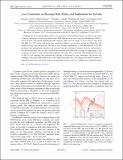| dc.contributor.author | Cohen, Timothy | |
| dc.contributor.author | Murase, Kohta | |
| dc.contributor.author | Rodd, Nicholas L. | |
| dc.contributor.author | Safdi, Benjamin Ryan | |
| dc.contributor.author | Soreq, Yotam | |
| dc.date.accessioned | 2017-07-21T18:24:16Z | |
| dc.date.available | 2017-07-21T18:24:16Z | |
| dc.date.issued | 2017-07 | |
| dc.date.submitted | 2017-04 | |
| dc.identifier.issn | 0031-9007 | |
| dc.identifier.issn | 1079-7114 | |
| dc.identifier.uri | http://hdl.handle.net/1721.1/110805 | |
| dc.description.abstract | Utilizing the Fermi measurement of the γ-ray spectrum toward the Inner Galaxy, we derive some of the strongest constraints to date on the dark matter (DM) lifetime in the mass range from hundreds of MeV to above an EeV. Our profile-likelihood-based analysis relies on 413 weeks of Fermi Pass 8 data from 200 MeV to 2 TeV, along with up-to-date models for diffuse γ-ray emission within the Milky Way. We model Galactic and extragalactic DM decay and include contributions to the DM-induced γ-ray flux resulting from both primary emission and inverse-Compton scattering of primary electrons and positrons. For the extragalactic flux, we also calculate the spectrum associated with cascades of high-energy γ rays scattering off of the cosmic background radiation. We argue that a decaying DM interpretation for the 10 TeV–1 PeV neutrino flux observed by IceCube is disfavored by our constraints. Our results also challenge a decaying DM explanation of the AMS-02 positron flux. We interpret the results in terms of individual final states and in the context of simplified scenarios such as a hidden-sector glueball model. | en_US |
| dc.description.sponsorship | Massachusetts Institute of Technology (MIT Pappalardo Fellowship in Physics) | en_US |
| dc.description.sponsorship | United States. Department of Energy (Cooperative Research Agreement DE-SC-0012567) | en_US |
| dc.description.sponsorship | United States. Department of Energy (Cooperative Research Agreement DE-SC-0013999) | en_US |
| dc.publisher | American Physical Society | en_US |
| dc.relation.isversionof | http://dx.doi.org/10.1103/PhysRevLett.119.021102 | en_US |
| dc.rights | Article is made available in accordance with the publisher's policy and may be subject to US copyright law. Please refer to the publisher's site for terms of use. | en_US |
| dc.source | American Physical Society | en_US |
| dc.title | γ-ray Constraints on Decaying Dark Matter and Implications for IceCube | en_US |
| dc.type | Article | en_US |
| dc.identifier.citation | Cohen, Timothy et al. “γ -Ray Constraints on Decaying Dark Matter and Implications for IceCube.” Physical Review Letters 119.2 (2017): n. pag. © 2017 American Physical Society | en_US |
| dc.contributor.department | Massachusetts Institute of Technology. Center for Theoretical Physics | en_US |
| dc.contributor.department | Massachusetts Institute of Technology. Department of Physics | en_US |
| dc.contributor.mitauthor | Safdi, Benjamin Ryan | |
| dc.contributor.mitauthor | Soreq, Yotam | |
| dc.relation.journal | Physical Review Letters | en_US |
| dc.eprint.version | Final published version | en_US |
| dc.type.uri | http://purl.org/eprint/type/JournalArticle | en_US |
| eprint.status | http://purl.org/eprint/status/PeerReviewed | en_US |
| dc.date.updated | 2017-07-13T22:00:03Z | |
| dc.language.rfc3066 | en | |
| dc.rights.holder | American Physical Society | |
| dspace.orderedauthors | Cohen, Timothy; Murase, Kohta; Rodd, Nicholas L.; Safdi, Benjamin R.; Soreq, Yotam | en_US |
| dspace.embargo.terms | N | en_US |
| dc.identifier.orcid | https://orcid.org/0000-0001-9531-1319 | |
| mit.license | PUBLISHER_POLICY | en_US |
| mit.metadata.status | Complete | |

